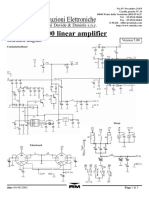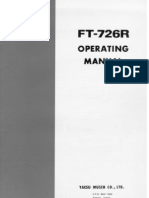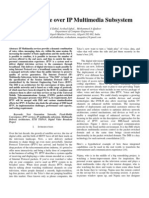The Imax 2000 Exposed
The Imax 2000 Exposed
Uploaded by
bellscbCopyright:
Available Formats
The Imax 2000 Exposed
The Imax 2000 Exposed
Uploaded by
bellscbOriginal Description:
Original Title
Copyright
Available Formats
Share this document
Did you find this document useful?
Is this content inappropriate?
Copyright:
Available Formats
The Imax 2000 Exposed
The Imax 2000 Exposed
Uploaded by
bellscbCopyright:
Available Formats
The Imax 2000 EXPOSED!
The Imax 2000 EXPOSED!
Have you ever wondered what was inside the Imax 2000 antenna?
After dissecting the Antron 99 antenna and discovering that its advertising claims were horribly
over-exaggerated, I became curious about other fiberglass 'wonder' antennas. An opportunity to
dissect the Imax 2000 presented itself, so I accepted.
The first thing you notice about the Imax 2000 is that it is LONG! I measured the copper wire
elements after they were removed from their fiberglass radomes:
Bottom section: 80 inches
Middle section: 94 inches
Top section: 96.5 inches
That makes the total radiating element length 270.5 inches. Using 27 MHz. (CB) as center
frequency (which this antenna was designed for), that makes the Imax 2000 a 0.640 wavelength
antenna. (A 5/8 wave antenna is 0.625 of one wavelength). I was very surprised to find that the
Imax 2000 is not a 5/8 wave as advertised. The Imax 2000 is actually a .64 wave! The .64 wave
is one of the best kept secrets in CB and 10 meter antennas. Not since the Super Penetrator
500 Gold has there been a .64 wave antenna widely available. A .64 wave antenna is the
highest gain single element design there is with 0.4 dB more gain on the horizon (free space)
than a 5/8 wave element.
In photo number 1 I have the antenna
laid out with the insides alongside the
fiberglass shell it was once housed in.
Removing the insides from the 2
lower sections was accomplished with
a Dremel tool and a cutting wheel.
Removing the insides of the upper
section required a planer and
systematically shaving away
fiberglass until I got down to the
copper wire inside. I had to determine
if there were any coils or anything
inside the top section. Instead, it's just
a length of stranded copper wire.
However, with a .64 wavelength
element, adding coils would distort the otherwise clean pattern, so I was glad to find just
http://www.video-observer.com/imax/imax2000.htm (1 of 7)1/19/2009 5:23:01 AM
The Imax 2000 EXPOSED!
the wire. The only thing that could improve this antenna would be a counterpoise (ground
planes). More on this later.
In photo 2, you see what is inside the
lower section and how the tuning
rings affect the coil's tuning. Except
for the lower 2 feet of the Imax 2000,
all the rest of the antenna contains
nothing more than a straight piece of
#14 bare copper wire. An upgrade
from the A99, the Imax 2000 uses RG-
213 coaxial cable which connects to
the SO-239 connector in the bottom
of the mounting pipe and to the coils
of the matching section. Just to the
right the outer coil is the brass outer
'plate' of the coupling capacitor. The
'twin ring' match works by moving the
metal rings closer or further away from the outer coil which changes the inductance and
therefore, the resonant frequency of the radiating element.
In photo 3, you can see how the
coaxial cable connects to the Imax
2000 feedpoint at the bottom of the
coils. There was a small plastic
spacer that I removed for the clarity of
the photo. Here, you can see that the
soldering job was excellent and very
electrically secure. Using the brass
crimp sleeve seen here helps add a
mechanical strength to the solder joint
which will help the antenna maintain
it's electrical integrity through
vibration and temperature
fluctuations. The inductance tuning
coil in the Imax 2000 is much smaller
(and less lossy) than the Antron 99 antenna. The Imax 2000 uses 10 turns of #14
enameled copper wire.
http://www.video-observer.com/imax/imax2000.htm (2 of 7)1/19/2009 5:23:01 AM
The Imax 2000 EXPOSED!
Photo 4 gives you a good view of how
the inner impedance matching coil fits
inside the outer tuning coil. With the
radiator length being .64 wave, the
impedance at this point is extremely
high. The inner coil provides a 50
ohm tap on the driven element, while
the outer coil cancels out the
capacitive reactance created by the
coupling capacitor and the
capacitance at the fed end of the
radiator. One of the big secrets to
getting a wideband antenna, which
many other antenna makers
apparently ignore, is completely
canceling out the reactance. Even a few ohms of reactance at the feedpoint will greatly
reduce the bandwidth. By tuning the reactance to zero, the SWR will be very low over a
wide frequency range.
Photo 5 provides a look inside the
coupling capacitor viewed from the
radiating element end. If you look
carefully, you will be able to see the
excellent soldering job from the
copper wire to the brass inner 'plate'
of the capacitor. Here, as in the
Antron 99, you also see another
brass crimp sleeve used to
strengthen the capacitor plate stub to
radiator element solder joint. The
Imax 2000 is built much better than
the Antron 99 reviewed in an earlier
article. The attention to solder joints
was much better in the Imax 2000,
and I was very pleased to see this attention to detail. It makes for a much 'quieter' antenna.
http://www.video-observer.com/imax/imax2000.htm (3 of 7)1/19/2009 5:23:01 AM
The Imax 2000 EXPOSED!
In photo 6, you get a look at the nylon
spacer which forms the 'dielectric' of
the coupling capacitor. I had to use a
great deal of heat to remove the
press fit brass sleeve, so some
melting of the nylon is evident. There
is NO WAY this would come apart by
accident! Like the Antron 99 coupling
capacitor, when measured with a
capacitance meter, I measured a
value of 4pF for each end. That's
measured radiator-to-sleeve and
again from ground-to- sleeve. The
Imax 2000 radiating element is
capacitively coupled rather than
connected directly to the coax to isolate the antenna base from high voltages in case the
installer happens to drop it across power lines and the radiator happens to make contact
with high voltage.
Photo 7 shows the inside of the
capacitor coupling unit with the
components alongside each other for
spacing reference. A brass cylinder
inside the nylon forms the inner
conductor or 'plate' of each end of the
coupling capacitor. The brass
cylinders do not touch each other end
to end, there is a small space left
which acts like a spark gap in the
case of lightning strike to take the
charge straight to ground. For a more
detailed idea of how this works, check
out the schematic diagram below.
http://www.video-observer.com/imax/imax2000.htm (4 of 7)1/19/2009 5:23:01 AM
The Imax 2000 EXPOSED!
CLOSING STATEMENTS: In summary, the Imax 2000 is a very well built and well
thought out antenna. It's ironic that the Antron 99 paved the way for this antenna, but the
Imax 2000 is head and shoulders above the Antron 99 in engineering practice. So much
additional inductance coil is needed in the Antron 99 to get the highly capacitive 1/2 wave
element tuned. However, in the Imax 2000, with the .64 wavelength element, the
capacitance is much lower, which requires much less inductance to tune it out. Therefore,
much less coil is required to tune the Imax 2000 to resonance, which greatly reduces the
coil losses.
So what is the TRUE gain of the Imax 2000? Assuming a .64 wave shunt fed dipole in free
space, minus the losses associated with the series capacitance and inductance, and minus
the necessary counterpoise, according to my math, the Imax 2000 has 2.9 dBi gain. That is
to say, the Imax 2000 has 2.9 dB gain on the horizon over an isotropic radiator. Referenced
to a center fed 1/2 wave dipole, which is the industry standard, the Imax 2000 has a gain of
0.8 dB. This could also be stated as 0.8 dBd gain. Although adding the Antron GPK-1
ground plane kit will not add much gain to the Antron 99, the ground plane kit would add
significant gain on the horizon for the Imax 2000. A .64 wavelength radiator is much more
efficient and will have a much lower angle of radiation (keep the signal down on the horizon
instead if wasting it up in the sky) with a proper counterpoise system. Adding the GPK-1 to
the Imax 2000 (according to my math and previous .64 wavelength test range plots) will
result in a 0.3 dB gain improvement. This will bring the Imax 2000's actual gain up to 3.2
dBi (or 1.1 dBd).
http://www.video-observer.com/imax/imax2000.htm (5 of 7)1/19/2009 5:23:01 AM
The Imax 2000 EXPOSED!
For a complete
report of the Imax
2000 on the
antenna test range
compared with and
without the ground
plane kit added,
click on the plot or
HERE .
CONCLUSION: The Imax 2000 will easily outperform the Antron 99 and other 1/2 wave
antennas like the popular 'Ringo'. Adding the GPK-1 ground plane kit will provide a
significant improvement in gain on the horizon, which will noticeably improve local
communications. With the wide availability and reasonable price of the Imax 2000, it is
easy to suggest this antenna to the 10 and 11 meter enthusiast who desires top
performance, and a more visually low profile fiberglass antenna.
Thanks: Special thanks to Copper Electronics ( www.copper.com ) for graciously
providing the antenna for this review.
Interested in the Solarcon A99? See: The Antron 99 EXPOSED!
This website is possible thanks to: QSL.net
http://www.video-observer.com/imax/imax2000.htm (6 of 7)1/19/2009 5:23:01 AM
The Imax 2000 EXPOSED!
Our sponsor:
About the author:
The author is a professional broadcast engineer with over 20 years experience in the design, maintenance, and
construction of broadcast transmitter and studio facilities. He has experience with high power antenna installations and
has been involved with simple single antenna installations to complex phasing and directional arrays. The author is
currently a successful contract engineer in California and has become highly respected and well known in the industry.
http://www.video-observer.com/imax/imax2000.htm (7 of 7)1/19/2009 5:23:01 AM
You might also like
- Optimum BillDocument4 pagesOptimum BillIvan JanjuševićNo ratings yet
- Galaxy Dx959 ModsDocument6 pagesGalaxy Dx959 ModsAdam100% (1)
- Browning Mark 3 Owners ManualDocument18 pagesBrowning Mark 3 Owners Manualcsr85024No ratings yet
- Power ModDocument6 pagesPower ModANSELMO LIMANo ratings yet
- RCI-6900F HP-TB Service ManualDocument41 pagesRCI-6900F HP-TB Service Manualbellscb100% (2)
- Uniden President Grant MB8719Document2 pagesUniden President Grant MB8719Todd HoferNo ratings yet
- NPC RC Mods Pico PositivoDocument24 pagesNPC RC Mods Pico Positivoricampos08100% (2)
- Costruzioni Elettroniche: Mod. KL 800 Linear AmplifierDocument4 pagesCostruzioni Elettroniche: Mod. KL 800 Linear AmplifierPisu Miau Pisu Miau100% (1)
- Kenwood TS-940S Fixes ReviewsDocument151 pagesKenwood TS-940S Fixes Reviewsk1dnrNo ratings yet
- 60W Linear Amplifier With IRF840Document1 page60W Linear Amplifier With IRF840Marco Aurelio100% (1)
- SAMS Photofact Index PDFDocument22 pagesSAMS Photofact Index PDFBillyBob Sowbreath0% (1)
- Martin - g8jnj - Comet Cha-250bDocument15 pagesMartin - g8jnj - Comet Cha-250bCésar Paz100% (1)
- Neets - Module 07Document287 pagesNeets - Module 07Majeir Joy Abundabar AsisNo ratings yet
- Texas Ranger TR-696F Owners ManualDocument10 pagesTexas Ranger TR-696F Owners ManualbellscbNo ratings yet
- Texas Ranger TR-696F-SSB Owners ManualDocument10 pagesTexas Ranger TR-696F-SSB Owners ManualbellscbNo ratings yet
- Texas Ranger TR-193wx Owners ManualDocument8 pagesTexas Ranger TR-193wx Owners ManualbellscbNo ratings yet
- Texas Ranger TR-296-GKDX Owners ManualDocument20 pagesTexas Ranger TR-296-GKDX Owners ManualbellscbNo ratings yet
- Microprocessor Interfacing and Programming: Laboratory ManualDocument7 pagesMicroprocessor Interfacing and Programming: Laboratory Manualf180535 SajjadAhmadNo ratings yet
- Airtel Marketing MyopiaDocument36 pagesAirtel Marketing MyopiaBaskar NarayananNo ratings yet
- Adapting The Astatic d104 MicDocument3 pagesAdapting The Astatic d104 MicFred Bohn100% (1)
- Anytone AT5555 enDocument23 pagesAnytone AT5555 enBlack Onion100% (1)
- Costruzioni Elettroniche: Mod. KLV 1000 Linear AmplifierDocument4 pagesCostruzioni Elettroniche: Mod. KLV 1000 Linear AmplifierPisu Miau Pisu Miau100% (2)
- Test Report Uniden Bearcat 980 ENGDocument86 pagesTest Report Uniden Bearcat 980 ENGStephanie Hall100% (1)
- I. Basic Troubleshooting & Repair SectionDocument11 pagesI. Basic Troubleshooting & Repair Sectiongilson p santosNo ratings yet
- Full Manual: Hf/50 MHZ TransceiverDocument173 pagesFull Manual: Hf/50 MHZ TransceiverBenjamin DoverNo ratings yet
- Ic-746pro ModsDocument34 pagesIc-746pro ModsHalisson de OliveiraNo ratings yet
- MFJ 299 ModifiedDocument4 pagesMFJ 299 ModifiedJackson VerissimoNo ratings yet
- DX 5000 Plus User Manual NewDocument17 pagesDX 5000 Plus User Manual NewclaudiodelbiancoNo ratings yet
- Manual All MultizetDocument9 pagesManual All MultizetalbundNo ratings yet
- Mod. KLV 400 Linear Amplifier Costruzioni Elettroniche: Di Marchioni Davide & Daniele S.N.C. Schematic DiagramDocument3 pagesMod. KLV 400 Linear Amplifier Costruzioni Elettroniche: Di Marchioni Davide & Daniele S.N.C. Schematic DiagramPisu Miau Pisu MiauNo ratings yet
- SuperTune ModificationsDocument25 pagesSuperTune ModificationsTodd HoferNo ratings yet
- 3600xxx SSB Mosfet PDFDocument13 pages3600xxx SSB Mosfet PDFricampos08No ratings yet
- Expo Full ListDocument2 pagesExpo Full ListRick Longest0% (1)
- MarsDocument25 pagesMarsFilgueiras JrNo ratings yet
- RCI-2980 Owners ManualDocument11 pagesRCI-2980 Owners Manualbellscb50% (2)
- FM Detector Fix: President LincolnDocument3 pagesFM Detector Fix: President LincolnSergio Iparraguirre LiañoNo ratings yet
- Icom Ic-7300 Low SSB Power Modification by Sp3rnz-1Document5 pagesIcom Ic-7300 Low SSB Power Modification by Sp3rnz-1Luis CuberoNo ratings yet
- Yaesu FT-726R Operating ManualDocument45 pagesYaesu FT-726R Operating ManualYayok S. AnggoroNo ratings yet
- Costruzioni Elettroniche: Mod. KL 501 Linear AmplifierDocument4 pagesCostruzioni Elettroniche: Mod. KL 501 Linear AmplifierLuis CarlosNo ratings yet
- rfx75 Install Guide Cobra 29Document3 pagesrfx75 Install Guide Cobra 29Geraldrum Zyzcom HdzNo ratings yet
- 148 GTL Block DiagramDocument3 pages148 GTL Block DiagramSuper ManNo ratings yet
- Inexpensive 17-Meter VerticalDocument10 pagesInexpensive 17-Meter VerticalSwlVUNo ratings yet
- Servicemanual RM Kl60 Eng ItaDocument2 pagesServicemanual RM Kl60 Eng ItaGabriel Mirciu75% (4)
- 3600xxx SSB MosfetDocument13 pages3600xxx SSB Mosfetbill1068No ratings yet
- Antenna Analyzer vk5jst Version 1 Instructions PDFDocument10 pagesAntenna Analyzer vk5jst Version 1 Instructions PDFPisu Miau Pisu Miau100% (1)
- Sigma4 Av174 OmDocument12 pagesSigma4 Av174 Omw8ddw2014No ratings yet
- Galaxy Owners Manual DX2547Document12 pagesGalaxy Owners Manual DX2547bellscbNo ratings yet
- Antena J-Pole Za 440 MHZ (70Cm)Document1 pageAntena J-Pole Za 440 MHZ (70Cm)Smai HondoNo ratings yet
- KENWOOD TS 830 Service ManualDocument71 pagesKENWOOD TS 830 Service ManualRobert/YG2AKR100% (2)
- Astatic Wiring HandbookM0Document30 pagesAstatic Wiring HandbookM0Dexter DanielNo ratings yet
- HR2510 ModsDocument33 pagesHR2510 ModsJeffNo ratings yet
- Cobra BroadbandDocument6 pagesCobra BroadbandDark _100% (1)
- Powerwave February 2008 Antenna GuideDocument226 pagesPowerwave February 2008 Antenna GuideAlp KirNo ratings yet
- Cobra 29 LTD CHR Owners ManualDocument21 pagesCobra 29 LTD CHR Owners ManualbahbahaNo ratings yet
- PLL CBDocument28 pagesPLL CBEugenio Verdinelli100% (2)
- Modifications For The Kenwood TS-940Document10 pagesModifications For The Kenwood TS-940ursindNo ratings yet
- Squalo AntennaDocument10 pagesSqualo AntennaAdrian Sultanoiu100% (1)
- Antenna Tuner G3WMEDocument2 pagesAntenna Tuner G3WMEfox7878100% (2)
- The Radio Amateur's Hand Book: A Complete, Authentic and Informative Work on Wireless Telegraphy and TelephonyFrom EverandThe Radio Amateur's Hand Book: A Complete, Authentic and Informative Work on Wireless Telegraphy and TelephonyNo ratings yet
- G 3 LdoDocument2 pagesG 3 Ldoyd1bwkNo ratings yet
- Solarcon A-99 ReviewDocument4 pagesSolarcon A-99 ReviewAriel BecerraNo ratings yet
- Soldering StationDocument1 pageSoldering Stationdavid reyesNo ratings yet
- Horizontal Loop AntennaDocument3 pagesHorizontal Loop Antennagutentag.266No ratings yet
- Quick Installation and Start-Up Guide: ACS880-M04 DriveDocument2 pagesQuick Installation and Start-Up Guide: ACS880-M04 DriveYacine MesnataNo ratings yet
- Coil On Plug IgnitionDocument4 pagesCoil On Plug IgnitionFabricio LimaNo ratings yet
- LSI Crescent Series Brochure 1989Document4 pagesLSI Crescent Series Brochure 1989Alan MastersNo ratings yet
- Structural Study of The Dynamo: NEE 2106 - 1ME Subject & SectionDocument6 pagesStructural Study of The Dynamo: NEE 2106 - 1ME Subject & SectionRaf Mid-dayNo ratings yet
- Resistor and CapacitorDocument14 pagesResistor and CapacitorAbdulAzeezNo ratings yet
- Ic 706mkiigDocument75 pagesIc 706mkiigiz2bkt100% (1)
- Volume 18Document80 pagesVolume 18bellscbNo ratings yet
- Rci-2950 Rci-2970 - 150: DX DXDocument11 pagesRci-2950 Rci-2970 - 150: DX DXbellscb100% (2)
- RCI 2950DX 2970DX Service ManualDocument44 pagesRCI 2950DX 2970DX Service Manualbellscb100% (2)
- RCI-6300F HPTB Service ManualDocument45 pagesRCI-6300F HPTB Service ManualbellscbNo ratings yet
- Volume 17Document80 pagesVolume 17bellscb100% (1)
- Owner's Manual 77-120 ESPDocument13 pagesOwner's Manual 77-120 ESPbellscbNo ratings yet
- Midland 79-290Document13 pagesMidland 79-290bellscbNo ratings yet
- RCI-2980 Owners ManualDocument11 pagesRCI-2980 Owners Manualbellscb50% (2)
- Texas Ranger TR-966 Owners ManualDocument11 pagesTexas Ranger TR-966 Owners ManualbellscbNo ratings yet
- Owner's Manual 77-092: 40 Channel Mobile Citizens Band TransceiverDocument11 pagesOwner's Manual 77-092: 40 Channel Mobile Citizens Band TransceiverbellscbNo ratings yet
- Texas Ranger 5054dx3 Owners ManualDocument11 pagesTexas Ranger 5054dx3 Owners ManualbellscbNo ratings yet
- Texas Ranger TR-936 Owners ManualDocument8 pagesTexas Ranger TR-936 Owners ManualbellscbNo ratings yet
- Owner'S Manual: Solid State Citizens Band Am/Ssb Mobile TransceiverDocument12 pagesOwner'S Manual: Solid State Citizens Band Am/Ssb Mobile TransceiverbellscbNo ratings yet
- Texas Ranger TR-121cp Owners ManualDocument5 pagesTexas Ranger TR-121cp Owners ManualbellscbNo ratings yet
- Owner'S Manual: Solid State Citizens Band Am/Ssb Mobile TransceiverDocument12 pagesOwner'S Manual: Solid State Citizens Band Am/Ssb Mobile Transceiverbellscb100% (1)
- Owners Manual: Solid State Citizens Band AM Mobile Transceiver With Blue Illuminated LiteDocument11 pagesOwners Manual: Solid State Citizens Band AM Mobile Transceiver With Blue Illuminated LitebellscbNo ratings yet
- Owners Manual: Am / SSB Two Way Citizens Band Mobile Transceiver With Starlite Face PlateDocument13 pagesOwners Manual: Am / SSB Two Way Citizens Band Mobile Transceiver With Starlite Face Platebellscb100% (2)
- Mini Hi-Fi System: Service ManualDocument81 pagesMini Hi-Fi System: Service Manualjose GonzalesNo ratings yet
- Cardless CAS - V1.0-C - 20101123Document28 pagesCardless CAS - V1.0-C - 20101123armando.wellavNo ratings yet
- Unit - 2 Mobile Radio PropagationDocument51 pagesUnit - 2 Mobile Radio PropagationSai Anirudh SanagaramNo ratings yet
- IPTV Service Over IP Multimedia Subsystem: MD Zahid, Arshad Iqbal,, Mohammed A QadeerDocument9 pagesIPTV Service Over IP Multimedia Subsystem: MD Zahid, Arshad Iqbal,, Mohammed A QadeermaxventoNo ratings yet
- POS Check Sheet Updated LSI Serpong 1Document2 pagesPOS Check Sheet Updated LSI Serpong 1yaelahdah46No ratings yet
- Application Guide To RF Coaxial Connectors and CablesDocument6 pagesApplication Guide To RF Coaxial Connectors and CablesAnonymous 0qYv7WpgNo ratings yet
- Remote Control in Power Substation Autom PDFDocument8 pagesRemote Control in Power Substation Autom PDFMekonnen ShewaregaNo ratings yet
- Mapa de Aviación en HF - Daniel (EA4FFI)Document1 pageMapa de Aviación en HF - Daniel (EA4FFI)ayrtonnoibileNo ratings yet
- 01 Introduction To AVRDocument21 pages01 Introduction To AVRmohammed ahmedNo ratings yet
- Title of Project: Vidyavardhini'S Bhausaheb Vartak PolytechnicDocument28 pagesTitle of Project: Vidyavardhini'S Bhausaheb Vartak Polytechnic440 Anushka Salve100% (1)
- Woot17 Paper BenadjilaDocument13 pagesWoot17 Paper BenadjilaKaci AmaoucheNo ratings yet
- Computer Organization and Architecture 18EC35: Course Handling Faculty: Gahan A VDocument72 pagesComputer Organization and Architecture 18EC35: Course Handling Faculty: Gahan A VDeepshikhaNo ratings yet
- Manual ApagadoresDocument6 pagesManual ApagadoresMoises CamarilloNo ratings yet
- ST - Anne'S: Ec8652 Wireless CommunicationDocument26 pagesST - Anne'S: Ec8652 Wireless CommunicationDeepthi SL CreationsNo ratings yet
- KDP57XBR2Document228 pagesKDP57XBR2amongeliNo ratings yet
- dl3000 Datasheet enDocument9 pagesdl3000 Datasheet enbillNo ratings yet
- Emotron Option Fieldbus 2 0 01 3698 01 R4 EnglishDocument98 pagesEmotron Option Fieldbus 2 0 01 3698 01 R4 EnglishRafael InacioNo ratings yet
- Jadwal Pelaksanaan Pekerjaan Kurva "S"Document1 pageJadwal Pelaksanaan Pekerjaan Kurva "S"Aldo Bona HasudunganNo ratings yet
- Antenna SpecificationsDocument3 pagesAntenna SpecificationsRobertNo ratings yet
- System Requirements Specification: European Integrated Railway Radio Enhanced NetworkDocument184 pagesSystem Requirements Specification: European Integrated Railway Radio Enhanced NetworkTiémogo TRAORENo ratings yet
- Section G5E-Electrical Power - A: Tentative 1 Faculty of Electrical and Computer EngineeringDocument5 pagesSection G5E-Electrical Power - A: Tentative 1 Faculty of Electrical and Computer Engineeringeyob feshaNo ratings yet
- VHQ Hexbeam Review 2021Document6 pagesVHQ Hexbeam Review 2021tomasNo ratings yet
- Software Defined RadioDocument290 pagesSoftware Defined Radiosharad_fss100% (1)
- User Manual Bruksanvisning Användarhandbok Brugervejledning Käyttöohje Lietotāja Rokasgrāmata Naudojimo Vadovas KasutusjuhendDocument72 pagesUser Manual Bruksanvisning Användarhandbok Brugervejledning Käyttöohje Lietotāja Rokasgrāmata Naudojimo Vadovas KasutusjuhendDaniel DrăganNo ratings yet
- Maloprodajni CjenikDocument17 pagesMaloprodajni CjenikEdi DeakNo ratings yet
- BlueHalo Titan CUAS 202308Document2 pagesBlueHalo Titan CUAS 202308Trung NguyễnNo ratings yet
- BBU3900 Description: Huawei Technologies Co., LTDDocument35 pagesBBU3900 Description: Huawei Technologies Co., LTDzbhp zNo ratings yet
















































































































